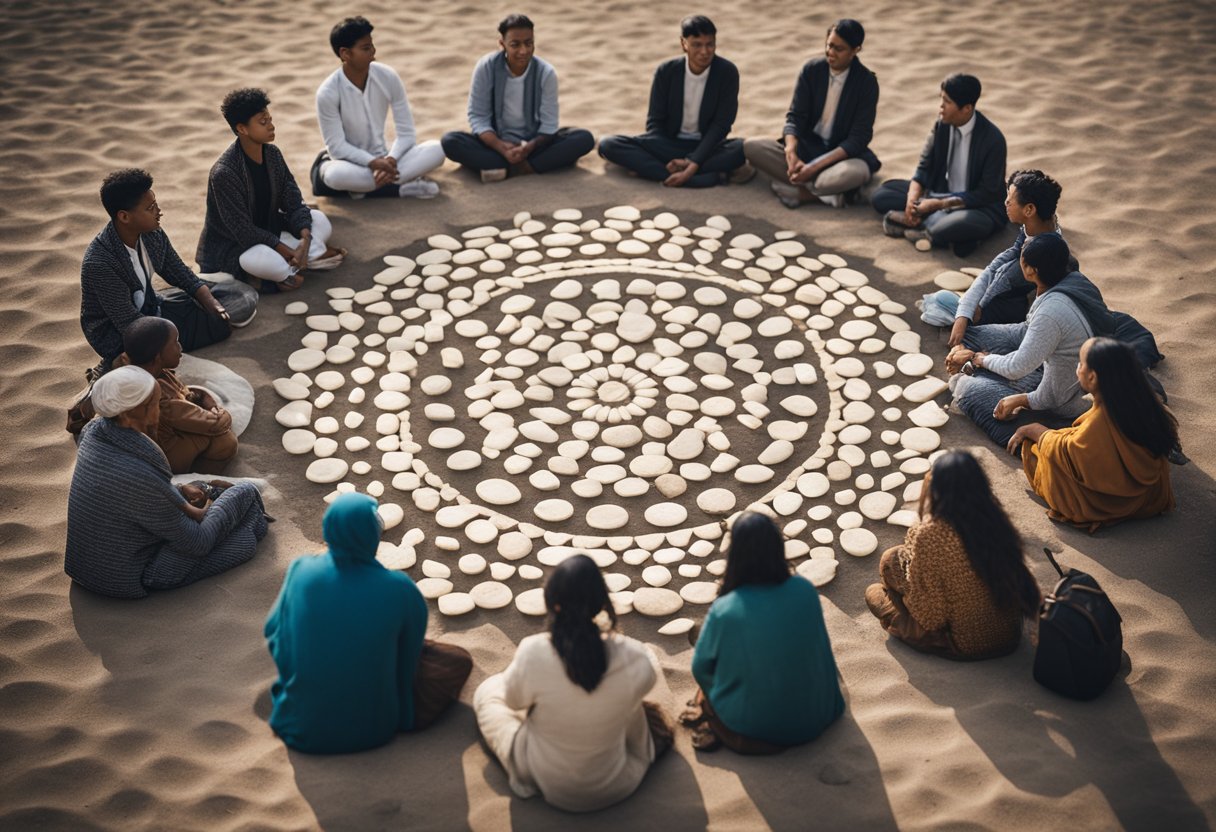Cross-cultural Rituals of the Equinox: Celebrations Around the World

Updated On: April 20, 2024 by Shaimaa Olwan
As the Earth progresses in its orbit, the equinoxes arise as moments of equilibrium, where day and night extend across the globe with near-perfect balance. These celestial events, part of the Cross-cultural Rituals of the Equinox, have been imbued with profound meaning across various cultures and have given rise to a myriad of rituals that honour the cyclical nature of time and the transitioning of seasons. The vernal equinox, heralding the onset of spring, and the autumnal counterpart, signalling the commencement of fall, are two cardinal points that have been celebrated by humanity for millennia, serving as a testament to our intrinsic connection to the natural world.

Intriguingly, the way we observe these equinoxes reflects deep cultural undercurrents, varying across continents and communities. The equinox has often been a focal point in rituals that span various themes, such as rebirth, fertility, and harvest. It’s a time for communities to come together, offering gratitude for nature’s bounty or seeking blessings for the coming months. These practices are not only rooted in local agriculture and environmental cycles but are also deeply interwoven with the spiritual beliefs and storytelling traditions of each region.
Table of Contents
Significance of Equinoxes in Different Cultures
The equinoxes, occurring twice a year, are moments of astronomical significance that have been marked by various cultural practices and rituals globally. To us, these celestial events symbolise more than just the equal length of day and night; they are deeply ingrained in cultural identities and historical traditions.
Vernal Equinox
The vernal equinox, signalling the onset of spring, has a special place across different societies. For many, it represents rebirth and renewal. In ancient times, the Mayans observed this day at the pyramid of El Castillo in Chichen Itza, performingsacrificial rituals to honour the changing seasons.
- Cultural Celebrations
- Spring Equinox – Celebrated with festivals and fertility rites in various cultures as a welcome to the new growth of the season.
- Cultural Norms – Traditions vary, from the intricate balance of eggs in China to symbolise fertility, to visiting ancestral graves in Japan.
Religious Significance
Equinox celebrations often blend with religious beliefs, exemplifying how celestial and spiritual worlds intertwine. In Christianity, the spring equinox determines the date for Easter, while pagans may observe it as Ostara, a time to welcome spring and dawn’s light.
- Pagan Traditions
- Emphasis on natural cycles, with rituals including spring cleaning and planting seeds, acknowledges the pagan reverence for earth’s fertility.
Historical Observance
Historically, equinoxes have been critical for agricultural societies that depended on seasonal changes. Monuments such as Stonehenge are thought to have been used to mark these occasions.
By celebrating the equinoxes, we honour our ancestors’ wisdom and maintain a living connection to our collective history and the cycles of nature that dictate our existence on this planet.
Rituals of the Equinox and its Traditions

Equinoxes are pivotal times of the year where cultural practices intersect with the celestial calendar. The equinox traditionally symbolises balance and renewal, prompting diverse rituals and festivals worldwide that reflect cultural beliefs about fertility, rebirth, and the cyclical nature of time.
Symbolism and Practice
Equinoxes hold significant symbolism in many cultures, representing a time of balance when daylight and darkness are of equal duration. It’s a moment that many associate with rebirth and fertility, as it often coincides with the emergence of spring in the Northern Hemisphere. In Christianity, Easter is observed around the spring equinox, a celebration of the resurrection of Jesus, symbolising rebirth. Conversely, the fall equinox might signal a time to prepare for the coming of winter, focusing on the harvest and appreciation of the earth’s bounty.
Pagan traditions often recognise the equinox as a sacred time as well. Mabon, the pagan festival during the autumnal equinox, is a time of thanksgiving for the fruits of the earth. Specific rituals include constructing altars, sharing feasts, and reflecting on the balance in one’s life.
Festivals and Commemorations
Festivals and commemorations during the equinox are both a spectacle and a profound marker of time and cultural identity. One of the most notable spring equinox celebrations can be found in the festival of Nowruz, which marks the Persian New Year and is deeply rooted in Zoroastrian traditions. It’s a time for emotional renewal and family gatherings, with various customs, such as the Haft-Sin table, which includes seven items symbolising new life, health, happiness, prosperity, joy, patience, and beauty.
The Jewish festival of Passover typically falls around the spring equinox. This commemoration of the Israelites’ liberation from slavery in ancient Egypt is rich in ritual and emotion, involving specific meals (Seder), storytelling, and recitations.
In terms of the autumn equinox, the emphasis often shifts to harvest festivals, celebrating the earth’s productivity and preparing for the scarcity of winter. Tables fill with crops, and communities come together to share the fruits of collective labour, binding time and emotion in gratitude and celebration.
It’s through these practised rituals and festive commemorations that we touch upon the essence of humanity’s attachment to the equinox – an enduring connection to the cycles of the earth that transcend geographical and cultural boundaries.
Cultural Depiction of Time and Astronomy
We observe that across cultures, the astronomical practices related to the measurement of time reflect the deep interconnection between celestial events and human activities. These practices are firmly rooted in the observation of solar and lunar cycles, often informing agricultural calendars, which in turn guide community rituals, especially around key moments like the vernal equinox.
Solar and Lunar Cycles
The sun and moon have historically served as reliable indicators of time for many cultures. Our understanding is that solar cycles, marked by events such as solstices and equinoxes, have deep cultural significance. The vernal equinox, for example, is a moment of great importance found in EHRAF World Cultures data. It signals the arrival of spring and is often celebrated with festivals that denote themes of rebirth and renewal.
- Solar Year: Composed of the vernal equinox, summer solstice, autumnal equinox, and winter solstice.
- Lunar Month: Based on the moon’s phases, culminating in the new moon and full moon, each holding various cultural meanings.
The intricacy of these celestial bodies’ movements has been captured in numerous historical artefacts, with cultures creating sophisticated methods to track them, thus leading to the establishment of calendar systems with the sun and moon at their core.
Agricultural Calendars
Agricultural calendars are closely tied to the Earth’s journey around the sun and have been a cornerstone in many agrarian societies, dictating the timing of sowing and harvesting. For instance, communities monitor the sun’s position in relation to fixed stars to determine the precise moments to carry out certain agricultural practices.
- Planting Seasons: Dictated by the sun’s intensity and the length of the day.
- Harvest Cycles: Often aligned with specific lunar phases for optimising crop yield.
Our research emphasizes that such calendars are not mere tools for survival; they are imbued with cultural significance, influencing festivals, ceremonial observances, and social organisation. Each agricultural milestone is often an interplay of time, space, and culture, reflecting a civilisation’s understanding and adaption to the celestial order.
The Role of Food in Equinox Rituals

In various cultures, the equinox is a time when food plays a central role in celebrations, reflecting the themes of fertility, abundance, and community. As the balance of light shifts, families and communities come together to prepare and share meals that are deeply emblematic of their cultural heritage.
China and Vietnam, for example, observe the Moon Festival, where moon cakes are a notable delicacy. These pastries, filled with sweet bean paste and egg yolk, symbolise family unity and are shared among loved ones.
| Culture | Food | Symbolism |
|---|---|---|
| Chinese | Moon Cakes | Family and unity |
| Irish | Special dishes* | Prosperity and warmth |
*During equinox celebrations, foods like those prepared for the Grianan of Aileach, laden with symbolism of the season, could involve traditional Irish foods that provide a sense of warmth and home.
In Ireland, customary dishes that incorporate seasonal harvests highlight the communal aspect and the love that goes into preparing meals for family gatherings. This not only fosters a sense of togetherness but also connects us to our agricultural heritage and the cycle of seasons.
Throughout history, equinox feasts have been a means to celebrate the shift in seasons—a time for communities to come together in a social context and reflect on the passage of time. A common thread in these rituals is the love of home and family, manifested in the preparation and eating of food that is rich with cultural meaning.
In embracing these diverse culinary traditions, we not only enjoy the flavours of different cultures but also share in the universal human experience of marking the rhythms of the Earth, recognising the importance of fertility in our lives, both in terms of crops and creativity.
Equinox Rituals and the Natural World
The equinoxes play a significant role in marking the transition of seasons and are accompanied by various rituals that celebrate the intricate balance of nature.
Renewal and Fertility
The themes of renewal and fertility are deeply entrenched in equinox traditions. These natural phenomena symbolise rebirth and the resurgence of life. For instance, the practice of decorating eggs, which predates Easter, embodies the concept of new life and fertility. Eggs, with their promise of life encapsulated within a shell, are potent symbols of the equinox, especially the vernal equinox, heralding the onset of spring.
In various cultures, equinox rituals include the planting of seeds both literally in the earth and symbolically to represent the growth of new projects and the emergence of ideas. These fertility rituals not only express hope for abundant harvests and successful hunting but also for personal growth and well-being.
Land and Water Traditions
Relating to land and water traditions, the equinoxes are often celebrated by showing reverence to nature’s balance and its resources. Bodies of water, seen as sources of life and sustenance, are central to many ceremonies. Peoples around the world, during equinoxes, may engage in rituals that involve the ceremonial use of water, symbolising purification and the cleansing of the spirit and land.
The connection to the land is also emphasised through traditions such as visiting ancient graves or sacred sites, which are frequently aligned with the sun during the equinoxes. This practice, found at historic structures like the Grianan of Aileach, is a testament to our ancestors’ understanding of the cosmic rhythm and their desire to connect with the natural cycles of the earth and sky.
Gender, Identity and Equinox Rituals

The equinox serves as a potent symbol across various cultures, encompassing themes of renewal and balance. It is a time when the interplay of gender, identity, and traditional roles comes to the fore in communal celebrations and rites of passage.
Rites of Passage
Rites of passage during equinox celebrations often symbolise the transition from one stage of life to another. These ceremonies may be strongly tied to an individual’s gender and sexuality and can be a significant moment in asserting their identity and agency. For instance, some cultures use the vernal equinox as a time for young women to step into femininity, emphasising the connection between the earth’s fertility and their own bodies.
Gender Roles in Celebrations
Equinox rituals frequently reflect and reinforce traditional gender roles within a community. These roles are expressed through specific tasks or ceremonies, where men and women enact parts that have been passed down through generations and are deeply entwined with social norms and concepts of beauty and love. In the context of celebrations, it’s not just a division of labour but a means to honour the integral aspects of the community’s shared self.
Influence of Religion and Mythology
Equinoxes have long been enveloped in a tapestry of religious and mythological significance, marking more than just astronomical occurrences; they symbolise deeper cultural, spiritual and supernatural connotations across various beliefs. Druids and pagans, for instance, perceive the equinox as a time of balance and reverence for the earth, highlighted in celebrations such as the Grianan of Aileach in Ireland.
In Christianity, the Vernal Equinox indirectly determines the date of Easter, intertwining with the notions of rebirth and renewal that the equinox naturally suggests. Similarly, tied to lunar calendars, Judaism observes Passover, and Islam has significant periods reflective of the lunar cycles, with Ramadan being one such time.
Eastern religions also reflect on the changes of the equinox with rituals and festivities. For example, in Japan, both equinoxes are times of family commemoration, striking a balance between the living and the ancestral spirits.
The underpinning sense of luck or misfortune, depending on one’s actions during these critical times, is a thread running through many beliefs, affecting both individual and community behaviour. Here’s a glance at how equinoxes influence different traditions:
- Religion: Timings for pivotal religious festivals and periods.
- Magic: Engaging in practices deemed more potent at the equinox.
- Luck and Misfortune: Influencing day-to-day decisions based on auspicious timing.
- Mythology: Myriad legends explaining natural events.
- Fear: Precautions are taken to ward off evil.
These observances are compelling reminders that for many cultures, the equinoxes are not merely a celestial event but a moment of profound connection and reflection, bridging the gap between the earthly and the divine.
Cultural Practices Across Continents
As we observe the equinox, it’s fascinating to see how different cultures around the world have developed their own unique traditions and rituals to mark this celestial event. From ancient times to modern-day celebrations, these practices reflect the rich cultural diversity and identity each region holds.

Asia
In Asia, the equinox is a time of significant cultural importance. Japan celebrates Ohigan, a Buddhist tradition that involves visiting the graves of ancestors, reflecting on Buddhist teachings, and seeking a balance between the spiritual and the material world. The offerings of flowers and prayers at family altars stand testament to this deeply ingrained respect for one’s forebears.
Europe
Delving into Europe, many equinox traditions have roots deeply entwined with ancient religions and mythologies. On the British Isles, Stonehenge is a prehistoric site aligned with the solstices and equinoxes, drawing crowds who stand in awe as the sun rises perfectly between its stones on these days. Across parts of Europe, Christianity has interwoven itself with equinox customs, embodying themes of renewal and rebirth celebrated during Easter.
Americas
Across the Americas, equinox celebrations are a vivid tapestry of indigenous and modern practices. The Mayan pyramid of Chichen Itza in Mexico illuminates the ingenious astronomical understanding of the ancients, with the descent of the serpent shadow during the spring equinox captivating spectators yearly. Meanwhile, the Persian New Year, or Nowruz, observed by many in the western region of the continent, interlaces natural cycles with cultural festivities, signifying a period of renewal and rejuvenation.
Social and Psychological Aspects of Rituals

In our examination of rituals, particularly those tied to the equinox, we observe a rich tapestry of social and psychological elements. Rituals act as a bridge between individual agency and collective memory, linking people with the broader strokes of cultural heritage and shared human experience.
Social Influence: Rituals are inherently social constructs. They provide a framework for individuals within a society to express their social identity and reinforce social cohesion. Through shared experiences, rituals strengthen the bonds between members of a community and reaffirm the collective values and norms.
Psychological Impact: These shared practices have profound psychological implications. They facilitate a sense of belonging and allow individuals to navigate significant life transitions, underscoring their importance identified in various fields, from psychology to anthropology. Rituals can also serve as a mnemonic device, anchoring memory in physical and repetitive acts, thus facilitating remembrance and teaching of cultural lore and practices.
Theoretical Approaches: Numerous theories from the social sciences have sought to understand the functions of rituals. Cambridge University Press and similar academic outlets have long promoted exploration into these practices through the lenses of sociology, anthropology, and social psychology.
Cultural Variations: Across cultures, rituals are manifested in diverse ways but often share core features, highlighting a universal aspect of human psychology and sociology. The equinox, for example, is celebrated worldwide with variations in practices that reflect local customs, yet the underlying social and psychological purposes remain consistent.
By engaging in rituals, we, as individuals and as a community, reinforce the narratives and histories that give meaning to our existence. Equinox rituals exemplify the perennial human quest to align with nature’s cycles and the enduring need to mark time’s passage through significant, collective ceremonies.
Cross-Cultural Narratives and Storytelling

In observing the equinox, communities worldwide weave stories that reflect their cultural identity and values. This moment of celestial balance carries narratives that highlight themes of rebirth, mortality, and the renewal of love. Our storytelling traditions during this period often explore the tension between light and day, life and death, epitomising profound emotion and the cyclical nature of existence.
For instance, in the context of Easter, stories form a rich tapestry that connects folklore with religious teachings, illustrating themes of sacrifice and resurrection. These narratives are not mere recitals; they’re a gift of knowledge and a means to reinforce the sense of belonging and continuity within a culture.
Moreover, storytelling on the equinox is embellished with rituals that define our emory of the occasion and solidify our connection with the cycle of seasons. Whether it’s through dance, music, or recitation, these stories form a crucial part of our social fabric, infusing cultural nuance into shared human experiences.
Such as:
- Rebirth: Stories of fresh beginnings resonate across cultures, symbolising hope.
- Gift-giving: Many cultures exchange gifts to mark the equinox, reinforcing bonds.
- Festivities: Shared meals and communal gatherings feature in equinox traditions.
We find in these tales a shared human quest to understand the world and our place within it, and through this understanding, nurture the compassion and empathy that bonds us across cultures.
Modern Adaptations and Copyright Issues

In our increasingly globalised society, equinox celebrations have not only persisted but adapted to modernity. These events continue to reflect the cultural evolution and complexity of societies as they merge ancient practices with contemporary interpretations. Notably, the economic impact of festivals like Bali’s New Year and Persian Nowruz has increased due to their appeal to both locals and tourists.
One challenge modern adaptations face is copyright. For instance, as communities develop new rituals or reinterpret traditional ones, questions arise about the ownership of cultural norms and practices. Creatively reimagined events need to navigate the delicate balance between innovation and the potential infringement of intellectual property rights.
- For example:
- Re-enactments of historical rituals may require permission from copyright holders.
- Artworks or musical compositions created for these events can be protected, and their use can be restricted without consent.
Within this context, the observance of equinox celebrations like Passover, which may incorporate copyrighted materials such as prayer books or songs, must be conscious of these limitations. As guardians of our traditions, we ought to ensure that the preservation of our heritage doesn’t conflict with legal boundaries.
We should also be vigilant in honouring the original context of these practices, even as we allow for cultural evolution. It is our responsibility to maintain the integrity of traditions and respect the communities from which they originate. In doing so, we continuously work towards a culture that holds space for both reverence and novelty.
Frequently Asked Questions

In this section, we address some of the most commonly asked questions about the diverse traditions and practices observed during the equinoxes by various cultures around the world.
What traditions do various cultures observe during the spring equinox?
Cultures around the world celebrate the spring equinox in various ways; for example, in Japan, people observe Higan, a week of Buddhist ceremonies focused on the spiritual move from suffering to enlightenment. Iranians celebrate Nowruz, marking the new year with symbols of rebirth and renewal.
How is the autumn equinox commemorated across different societies?
During the autumnal equinox, different communities celebrate the balance between day and night with festivities. In the UK, some gather at Stonehenge for a Druid ceremony, while in Poland, people create and float handmade wreaths down rivers to signify the gradual shift to winter.
Which spring equinox customs are rooted in pagan beliefs?
Ancient pagan customs influence some modern spring equinox celebrations. For example, Pagan traditions named this time Ostara, symbolising new beginnings and fertility, often embodying these concepts with the hare and the egg, parallels seen today in modern Easter symbolism.
In what ways do ancient celebrations of the spring equinox influence modern practices?
Ancient celebrations, such as those held at sacred sites like Stonehenge, deeply influence modern practices with their emphasis on cycles of life, death, and rebirth. These time-honoured themes resonate in contemporary celebrations, seen in motifs of growth and new life infused into current-day festivities.
Can you describe some specific rituals associated with the fall equinox?
Specific rituals for the fall equinox include the Chinese Moon Festival, where families gather to appreciate the full moon and share mooncakes as a symbol of unity. In Mexico, the Mayans at Chichen Itza observe the descent of the serpent shadow on the El Castillo pyramid, representing the Kukulkan deity.
Which religions include the equinox in their ceremonial calendar, and how do they observe it?
Religions such as Christianity and Paganism mark the equinox in their calendars. Christians relate the vernal equinox to Easter, determining its date by the first Sunday after the first full moon post-equinox. Pagans celebrate Ostara with rituals that honour the balance of light and dark, emblematic of nature’s equilibrium.






